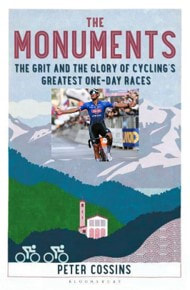
Van der Poel’s grandfather “… Raymond Poulidor, ‘The Eternal Second’ who finished on the Tour de France podium eight time but never won it, … not only missed out on the Tour title, but never even managed to spend a day in the Tour’s fabled yellow jersey”. Why would anybody be surprised that it might be extra special for his grandson? And there is more. Peter Cossins tells a wonderful tale about Poulidor’s victory. It starts with explaining how Poulidor “had decided to quit the race when he punctured in Varazze 125km from the finish and had to wait two minutes before Mercier team manager Antonin Magne appeared on the scene ...”. Magne’s strategic contribution to the victory is worth reading.
There are five parts to The Monuments – one for each of the races. Within each part there are four chapters. These chapters have a chronological order. While it is primarily a documentary account of how each race was won, it is more than just a sporting history. Ernest Hemmingway and Rudolph Valentino make a brief appearance. Politics is ever present in the book. Mussolini looms large. A decree renaming Sanremo as San Remo being the most obvious example. His regime is viewed as contributing to the reduction in foreign cyclists during the 1930s. This is not surprising in a sport where national identity is important for the cyclists, fans, and promoters. It is best captured in the words of the Italian Fausto Coppi after his 1946 win over a French rival. Coppi said, “My compatriots, who were weary and embittered by the war, were counting on me to bring them some satisfaction”.
Economics also runs through the chapters. In the early years, there is an explanation of the incentives for newspapers to establish and promote the race to a public who were heavily dependant on the bicycle in their everyday life. Later, as motorised bikes and cars become affordable, there is a discussion of the implications for team sponsorship. There are some wonderful descriptions of how cyclists would be provided with tangible incentives to win particular races. Lorries and sports cars being promised by those associated with the teams. There are financial incentives agreed between cyclists for cooperative effort or cooperative reduction in effort. And, throughout there is an account of how race organisers adapted the challenge of the route to provide a test for the riders and spectacle for the fans.
It is a lovely book that primarily examines the human stories about what happened on the road. It does not shy away from the darker side of the desire to win. Banned substances appear more frequently in later chapters but they are also there in the early years. By not turning a blind eye to what was happening, Cossins allows the reader to understand the context where the blind-eyed Biagio Cavanna openly aided rider performance with “substances designed to fortify them”. The human context frames our response. I got more enjoyment out of van der Poel’s win after reading about his grandfather.
 RSS Feed
RSS Feed